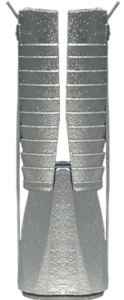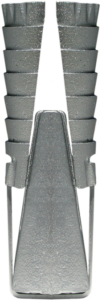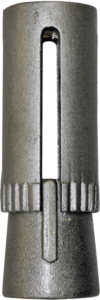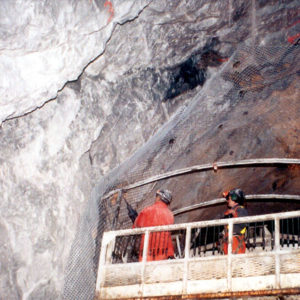Bail Anchors
Bail Anchors are fast setting mechanical anchors that are simple to use for light to moderate loads in temporary or permanent applications. They set in a one step torque tension operation and work well with Williams Grade 75 All-Thread Rebar, constant torque nuts and domed plates/spherical washer assemblies. They are well suited for use in single or twin grout tube installations due to the minimal rotation the bar undergoes during the setting process.
B-16 “One Step” Spin-Lock Anchor Head Assembly
Similar to the Spin-Lock anchors but with the advantage of being quickly set and tensioned in one torque operation using a Constant Torque Nut. These anchors are often used where pattern bolting of slope stabilization or tunneling projects require a medium duty fast production anchor. The nut has a special compressed end that acts initially as a setting tool and then under a higher torque overcomes the compressed threads in the nut to allow the nut to torque against the bearing plate to further set and tension the anchor in one step.
| Blank Part Number |
Range of Bar Diameter | Hole Diameter |
Ultimate Capacity |
Shell Length |
Wedge Length |
|
|---|---|---|---|---|---|---|
| UNC / Coil | Grade 75 | |||||
| R5M-F9F | 3/4” – 1” (20-25 mm) |
#6, #7 (20-22 mm) |
1-3/4” (45 mm) |
33-40 kips (147-178 kN) |
3-1/4” (83 mm) |
2-1/4” (57 mm) |
| R5M-D20 | 5/8” – 1-1/8” (16-28 mm) |
#6, #7, #8 (20-25 mm) |
2” (51 mm) |
15-50 kips (67-222 kN) |
4” (102 mm) |
3-7/8” (98 mm) |
| B-16 | 3/4” – 1” (20-25 mm) |
#6, #7, #8 (20-25 mm) |
2” (51 mm) |
33-79 kips (147-351 kN) |
4” (102 mm) |
2-1/4” (57 mm) |
Bail Anchor Installation
Bail anchors are initially set in the hole using relatively low torques that should not exceed 20 ft-lbs. Higher setting torques applied to the bail anchor alone will not help in the setting process. Final set of the Bail Anchor is accomplished through direct tension with a hydraulic jack or preferably by torquing the nut against the plate. This action pulls the cone further into the shell locking it into place. The outward migration of the bar is usually no more than 1” to 2” maximum. This movement must be anticipated and allowed for in the design and application of this anchor type in ungrouted conditions. Bail anchor installations are tested and grouted by normal methods.





